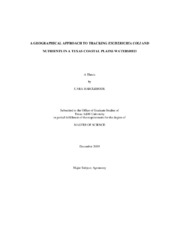| dc.description.abstract | Carters Creek in Brazos County, Texas, like many surface water reaches in the Texas Gulf Coast region, has been identified for bacteria and nutrient impairment on the Texas Commission on Environmental Quality (TCEQ) 303(d) List. Carters Creek drains a rapidly urbanizing watershed and has been found to carry high concentrations of dissolved organic carbon (DOC), nitrate, phosphate and sodium. These constituents have a severe impact on the creek?s capacity for healthy aquatic life and increase the potential for eutrophication downstream. The creek has also had chronic high Escherichia coli counts, making the creek unsuitable for contact recreation according to the accepted standard for surface water quality, which is a geometric mean of 126 CFU per 100 ml. In this study, grab samples were taken twice monthly from fifteen sites on Carters Creek and its subcatchments from July 2007 to June 2008. The samples were analyzed for E. coli, DOC, total N, NO3-N, NH4-N, Na+, K+, Mg2+, Ca2+, F-, Cl-, Br-, NO2-, SO42- and PO4-3. Mean annual DOC concentrations varied from 24.8 mg/L in Carter at Boonville Road to 55.5 mg/L in Wolfpen Creek; sodium varied from 33 mg/L in Carter at Old Reliance Road to 200 mg/L, also in Wolfpen Creek. Burton 4, the subcatchment with the highest geometric mean for E. coli with 2547 CFU/100 mL, was also sampled with greater geographical intensity for E. coli and optical brightener fluorescence at 445 nm to identify any leaking sewer pipes, but no evidence of defective pipes was found. During both the spring season and annual high flow (storm events), E. coli counts were positively correlated with total urban land use, probably caused by storm runoff carrying residues from impervious surfaces into the stream. High flow E. coli also had a negative relationship with potassium and a positive relationship with calcium, possibly suggesting a bioflocculation effect. Sites downstream of wastewater treatment plants (WWTPs) showed higher nitrate, phosphate, sodium, potassium, chloride and fluoride than other urban subcatchments. Creeks with golf courses carried more phosphate, sodium and fluoride than subcatchments without golf courses or WWTPs. | en |


